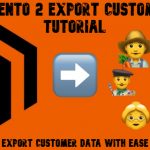Magento 2 Commerce (Adobe Commerce Cloud) In-Depth Review

The end of life and support for Magento 1 is coming! Therefore, we’ve decided to prepare this article describing the fore features of Magento 2 Commerce. After Adobe purchased the platform, we’ve faced several notable changes which are enough to migrate from your old e-commerce website to the latest Magento 2 version. But before doing that, let’s take a look at what Magento 2 Commerce (Adobe Commerce Cloud) offers.

Table of contents
Magento 2 Commerce Features
While the first version of the platform was quite limited, Magento 2 erases the boundaries of what is possible. The completely revamped system gives you the power to create a unique shopping experience, transforming your business with rapid and cost-effective innovations. Magento 2 combines top-notch performance and scalability with powerful business tools. This mix is developed to keep you ahead of two things:
- Increasingly complex commerce operations;
- Growing customer demands.
Let’s take a look at the core Magento 2 Commerce features to find out what really makes the platform so outstanding.
Customer Segmentation and Personalization

Modern customers reckon upon personalized experience when they visit an e-commerce website. Buyers want you to provide them with goods and services they expect to see. Luckily, Magento 2 Commerce is fully capable of such experience. Due to strong customer segmentation and personalization features, the platform lets you implement an individual approach to each client.
You can create a personalized shopping experience that boosts conversion rates. Magento 2 Commerce features provide the ability to dynamically display content, promotions, and pricing to specific customer groups using their location, gender, order history, lifetime purchase value, wishlist items, and more as a basis. As for unknown site visitors, the platform is powerful enough to target them using such data as products they have viewed or items in their cart.
And don’t forget that you can add new attributes to customer profiles with Magento 2 Commerce to create more sophisticated segments. Thus, personalized shopping experiences becomes as easy and efficient as possible with the platform’s advanced segmentation and targeting features.
Promotions and Pricing
Since we are talking about your interaction with customers, it is necessary to say a few words about promotions and pricing of Magento 2 Commerce. The platform lets you set promotional pricing for different parts of your digital storefront. For instance, you can apply discounted prices for specific stores, categories, customer segments, or products. Note that it is possible to import and export cart price rules to and from your Magento 2 website.
At the same time, the platform lets you create flexible coupons for specific stores, customer
segments, time periods, products, and categories. While Magento 2 Commerce lets you export them for offline distribution, email, newsletters, and more by default, you can freely import the existing codes and all the related data from any external source with the help of Improved Import & Export.
At the same time, the platform enables you to track and report coupon usage to see how efficient your new campaign is.
You can add coupons to automated reminders informing customers about abandoned carts. At the same time Magento 2 Commerce lets you send similar messages with a proposition to buy an item from a wishlist with a discount. To make your email campaigns more powerful, the platform provides the ability to leverage by dotmailer and live store data.
You can provide buyers with free shipping plus percent, fixed amount, or ‘buy X get Y free’ discounts. It is also possible to leverage multi-tier pricing for quantity discounts. Promotions and pricing capabilities of Magento 2 Commerce are almost endless, so you no longer need third-party extensions to leverage them. However, you may need Improved Import & Export to transfer the corresponding data from your old e-commerce website, even if it is not a Magento store.
Customer Loyalty
As for customer loyalty-specific features, they include reward points for various actions: purchases, registration, product reviews, etc. You can configure redemption rules, caps, and expiration dates.
Customers can save products to multiple wishlists and make them public. Furthermore, your registered buyers have the ability to create gift registries and send emails to other people to shop the registry. Item count is updated automatically while registry owners are notified about purchases. For further information, check this article: How to Import & Export Wishlist Items in Magento 2.

Also, Magento 2 Commerce allows customers to purchase physical and virtual gift cards. You can discover more fact about this feature here: How to Import & Export Magento 2 Commerce Gift Cards.
Advanced Product Relations
To make your targeting efforts more efficient, you also need to configure related products to create a solid product display. Magento 2 Commerce provides the ability to set automated rules to do that. Thus, you determine which products to present as up-sells, cross-sells, and related products to each customer segment.
All rules are available in the admin section along with the corresponding tool that enables easy administration through various conditions. As a result, you can effortlessly target product suggestions increasing sales and average order values.
Unfortunately, Magento 2 Commerce doesn’t let you import product relations seamlessly. But you can always leverage Improved Import & Export to do that. Follow this link for further information: The Complete Guide to Magento 2 Related Products, Up-sells, and Cross-sells, and how to import them.
SEO Enhancements
According to various reviews, Magento 2 Commerce is not the best e-commerce platform when it comes to SEO. However, it offers a bunch of powerful features in this area. First of all, the platform automatically generates a Google sitemap. Besides, it lets you create search engine friendly URLs as well as take full control over URL rewrites. And don’t forget about the ability to enable detailed search results based on structured data markup added to product pages automatically.
Elasticsearch
As for the Magento 2 Commerce search, it is based on the Elasticsearch engine out-of-the-box. The platform handles large catalogs and easily scale search capacity as queries grow. At the same time, Elasticsearch enhances other aspects of user experience. For instance, it offers suggestions for customer misspellings, support for stop words and attributes weight, synonym management, etc.
Powerful Shipping
Powerful shipping features of Magento 2 Commerce are very impressive as well. The corresponding tool lets you receive real-time shipping rates from the most popular service providers including UPS, FedEx, USPS, and DHL. Furthermore, you can effortlessly integrate shipping with label printing for all major carriers.
Besides, the platform lets you set flat rate shipping fees per order or item as well as table rates for weight, price, destination, and a number of items.
Order tracking from customer accounts or a configurable order tracking widget is another advantage of Magento 2 Commerce. And if you need to import tracking numbers to your e-commerce store, Improved Import & Export will help you. You can find more information here: How to Import Shipping Tracking Number to Magento 2.

Also, note that Magento 2 lets you specify allowed destination countries for every shipping method out-of-the-box. Another Commerce feature that is worth your attention is the ability to ship different items from a single order to multiple addresses. And when it comes to returns, you can process them from within the Magento 2 admin.
Advanced Payments
Numerous shipping options are only a small part of buyer-oriented changes introduced in Magento 2 Commerce. To make the life of your clients better, the platform enables advanced payment system. The integration with multiple payment gateways is available out-of-the-box. It includes such payment providers as PayPal, Authorize.net, Braintree, CyberSource, and WorldPay. If they are not enough, you can install additional payment extensions through the Magento Marketplace.
Despite the selected provider, the platform securely passes credit card information from the client browser to the payment gateway directly, bypassing the Magento application. Besides, it lets you qualify for PCI compliance. You can even leverage Braintree Hosted Fields to simplify this process.
Magento 2 Commerce features include support for the following payment options:
- PayPal Credit;
- Checks;
- Money orders;
- Purchase orders;
- Payments on account;
- Bank transfer payments;
- Cash on delivery.
You can leverage Signifyd automated fraud detection tools to decrease risks. The platform also lets you authorize and charge credit cards upon shipment.
As for increasing revenue, Magento 2 Commerce lets you streamline PayPal in-context checkout and saved credit cards. Besides, your customers can log in and pay with familiar and trusted Amazon Pay. Alternatively, they can use Klarna to pay now, later or in installments.
Support for Global Sites
Magento 2 enables you to run multiple country sites. Of course, different currencies and local tax rates are supported! Furthermore, Magento lets you work with any language due to the support for accented characters and right-to-left texts.
From the admin perspective, you can configure a list of countries allowed for different processes: registration, shipping, and/or billing.
As for EU-specific enhancements, they include:
- Support for WEEE/DEEE and other fixed product taxes in the EU;
- Automated tax calculations for transactions in the EU with VAT-ID validation;
- Support for EU cookie notification to simplify EU Privacy and ECD compliance.
You can import and export store-specific data using Improved Import & Export.
Integrated B2B Functionality

Another notable enhancement introduced in Magento 2 Commerce is its integrated B2B functionality. The platform lets you transform the buying experience of your business partners, increasing their loyalty, reducing costs, and driving new growth.
The most important Magento 2 Commerce B2B feature is the ability to create company accounts and set up multiple buyers with specific roles and responsibilities for them. Thus, you can work with single representatives or the whole teams representing the same business structure.
Another notable B2B improvement is represented by custom catalogs and price lists. Thus, you ensure the necessary personalization for your business clients. Buyers receive contract terms when purchasing online, while you can offer payments on account to increase sales. Check this article for further explanation: How to Import and Export Magento 2 Shared Catalogs.
A powerful quotation engine is another important B2B feature of Magento 2 Commerce. It lets your clients create quotes and discuss prices with you via a customer account. However, quote requests are not the only instrument of fast, friction-free purchasing. Other tools include quick order forms and requisition lists.
Also, note that the platform process long-running B2B shared catalog updates in the background while you can work on other administrative tasks!
You can find more information about these and other B2B features here: Magento 2 Commerce B2B Exploration. Also, note that any B2B data can be transferred to/from your e-commerce website with the help of Improved Import & Export.
You can find more information about these and other B2B features here: Magento 2 Commerce B2B Exploration. Also, note that any B2B data can be transferred to/from your e-commerce website with the help of Improved Import & Export and the B2B add-on. Below you can find a few words about such transfers.
Import or export of companies, company roles, quotes and negotiable quotes, shared catalogs, and requisition lists via the FireBear B2B add-on will help you organize a solid workflow, reduce time spent on client management, add business opportunities with various app integrations.
You are able to decide how to transfer your B2B data as the functionality support multiple import sources and data file formats. The data can be retrieved via REST and SOAP API, from FTP/SFTP, Google Sheets, Dropbox, URL, file upload. Selecting the format out of CSV, XML, Excel XLSX, ODS, Json, ZIP and TAR will help save time on data file composing and provide the experience friendly for you.
The B2B entities can be edited massively with the mapping feature. If there’s a need to repeat the transfers over time, you always able to schedule cron and update the database automatically.
Powerful Admin Experience
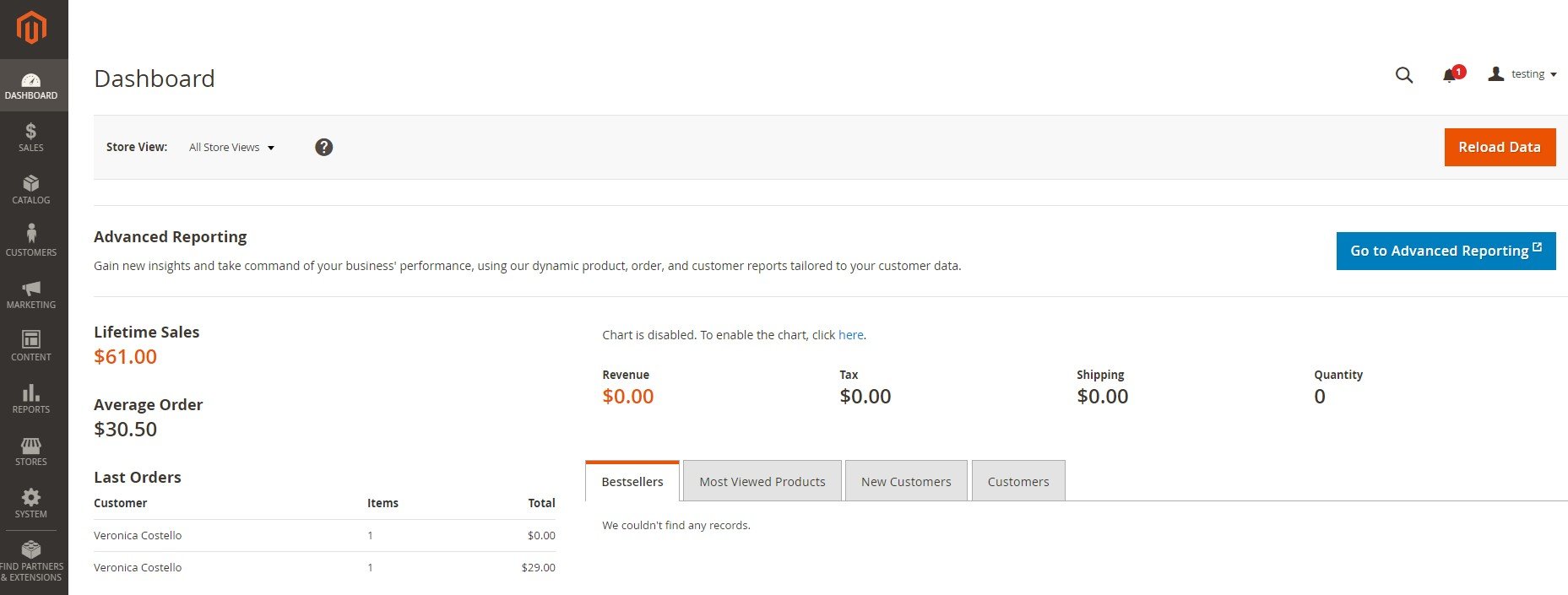
To increase the efficiency of your admin duties, Magento 2 offers a modern and intuitive user interface. With a powerful dashboard, you can easily monitor your business accessing sales, orders, search terms, bestsellers, etc. Enhanced navigation, advanced admin search, and multiple other features make it easy to find the information you need. Furthermore, management screens are fully customizable so that you can configure them according to your specific needs. Let’s see what exact areas are enhanced in Magento 2
Order Management
Deep order management capabilities of Magento 2 Commerce let you not only view but also edit, create, and fulfill orders and/or invoices right from the Admin panel. Besides, it is possible to create multiple invoices, shipments, and credit memos per order to enable split fulfillment. Note that invoices, packing slips, and shipping labels can be printed from the admin.
And with custom order status labels, you can easily track progress. Another vital tool introduced in Magento 2 Commerce is its RMA module, developed to process returns in the most efficient way. The platform even lets you issue store credits to refund orders.
As for importing orders to Magento 2, this process can be fully automated with Improved Import & Export. Follow this link for further information: How To Import Orders to Magento 2.
Customer Services
Rich customer services is another part of the powerful admin experience. The platform enables customer service representatives to create orders and customer accounts; update products, prices, and coupons in customers’ carts and wishlists; customize order statuses; update accounts; reset passwords, etc.
Besides, it is possible to monitor what products customers viewed and purchased recently. Monitoring their wishlist items form admin is also possible!
Content Staging
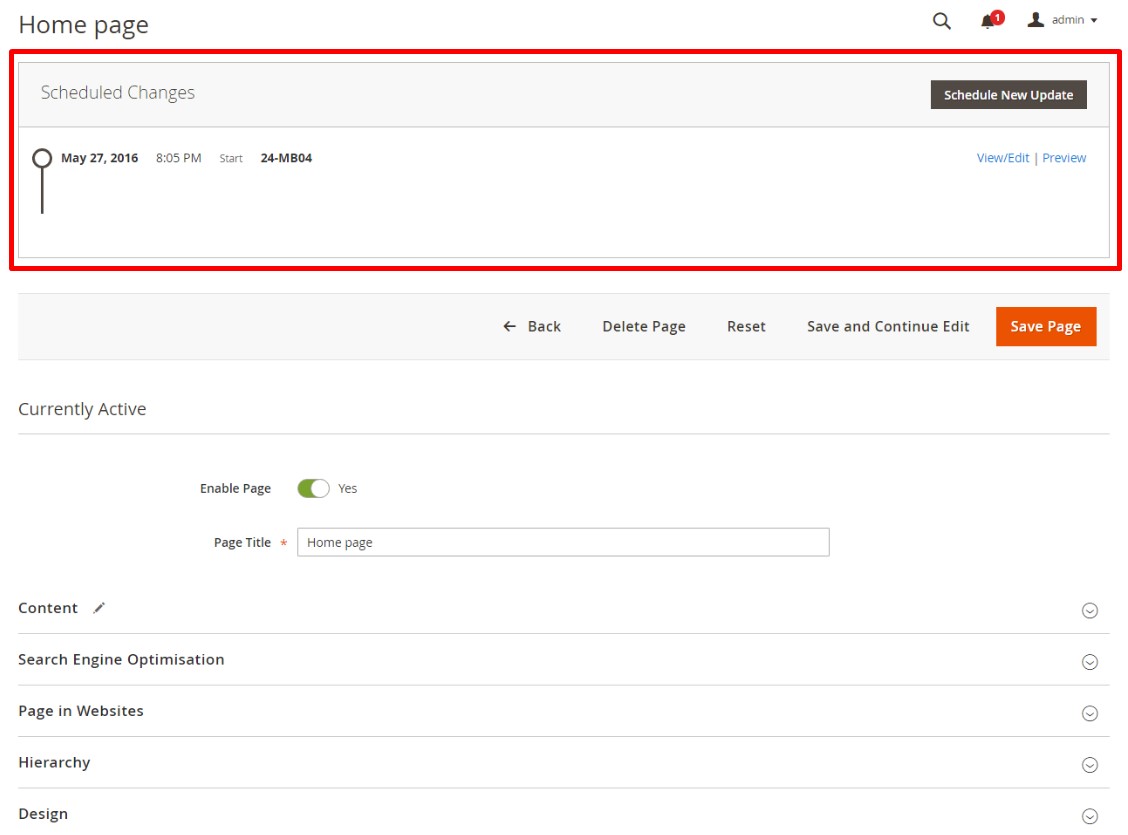
Content Staging is a Commerce-specific feature introduced in Magento 2. It lets you create, preview, and schedule a wide range of content updates without involving IT specialists. After a new update is created, you can preview it to guaranty a flawless shopper experience. Such a powerful tool lets you and optimize the timing and impact of site updates. Now, you can manage all changes through a timeline dashboard by yourself automatically deploying updates. Follow this link for further information: How to Import and Export Magento 2 Commerce Content Staging Data.
Visual Merchandiser
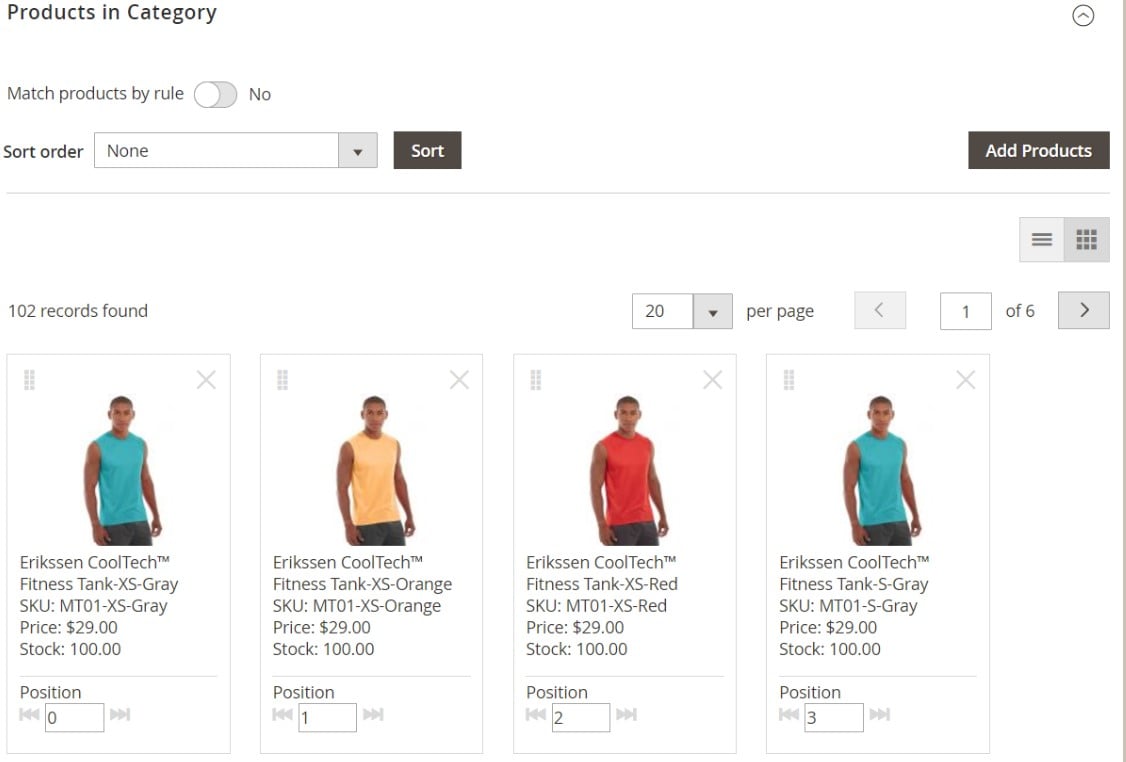
Another feature that dramatically simplifies backend duties is Visual Merchandiser. It lets you optimize product category pages by arranging products using a simple drag-and-drop interface. Alternatively, it is possible to leverage sorting rules that order products by the following parameters:
- Bestseller;
- Color;
- Highest margin;
- Newest addition.
You can save even more time by setting rules to assign products to specific categories automatically. The following attributes can be utilized: brand, price, or date created.
You can find more information about Visual Merchandiser as well as discover how to import/export the corresponding data here: How to Import & Export Magento 2 Visual Merchandiser Data.
Catalog Management
As for the catalog management features, Magento 2 Commerce offers a plethora of them. First of all, it lets you create simple, configurable, bundled, and grouped products as well as offer virtual products. At the same time, you can include downloadable/digital products with samples. Note that customer-personalized products are supported as well. And the creation of new products can be guided for the admin.
You can define unlimited product attributes as well as create pre-defined product templates to set up new products as fast as possible. To speed up your daily duties, Magento enables you to mass-assign a value to multiple products for batch updates. Furthermore, it is possible to assign products to specific categories automatically on the basis of attributes.
Other catalog management features include:
- Automated image resizing and watermarking;
- Inventory management with support for back-ordered items;
- Out-of-stock and inventory replenishment notifications;
- Minimum and maximum products in the cart
- Facebook ads and stores generation;
- Reviews and product tags moderation.
Note that the Improved Import & Export Magento 2 extension lets you transfer all catalog data to and from your e-commerce website: The Complete Guide to Magento 2 Product Import / Export.
Admin Security
To make your business more secure, Magento 2 Commerce lets you define multiple roles and permissions to enable different access levels for different administrators. At the same time, it is possible to log and review all admin activities. Adding CAPTCHA functionality is here to help you prevent automated software from attempting fake logins. You can also generate comprehensive system reports to diagnose and resolve various technical issues.
Advanced Frontend Experience
Below, you will find various ecommerce solutions and tools that simplify the life of Magento 2 store visitors. Let’s take a look at how simple the enhanced catalog browsing is.
Catalog Browsing

Your clients can effortlessly filter products in categories and search results using different parameters. For instance, Magento 2 lets them apply such filters as a price range, brands, color swatches, etc. Other attributes can be combined with layered navigation as well. Note that there are two ways your products are presented on a category page: as a grid or in a list format. You can customize the look and feel of categories and assigned product pages using the tools described above.
As for the personalization features mentioned previously, they let you control which products and categories are displayed to each customer group.
Another enhancement that is worth mentioning here is the ability to compare products side-by-side. Your clients can add two or more products to the comparison. Recently viewed or compared products can be displayed on the frontend.
At the same time, the aforementioned Elasticsearch engine affects not only the backend section but also the customer experience. It increases search relevancy and scalability, enables stop words, attributes weighting, and synonyms. You can also configure redirects for a search with no results.
Product Browsing
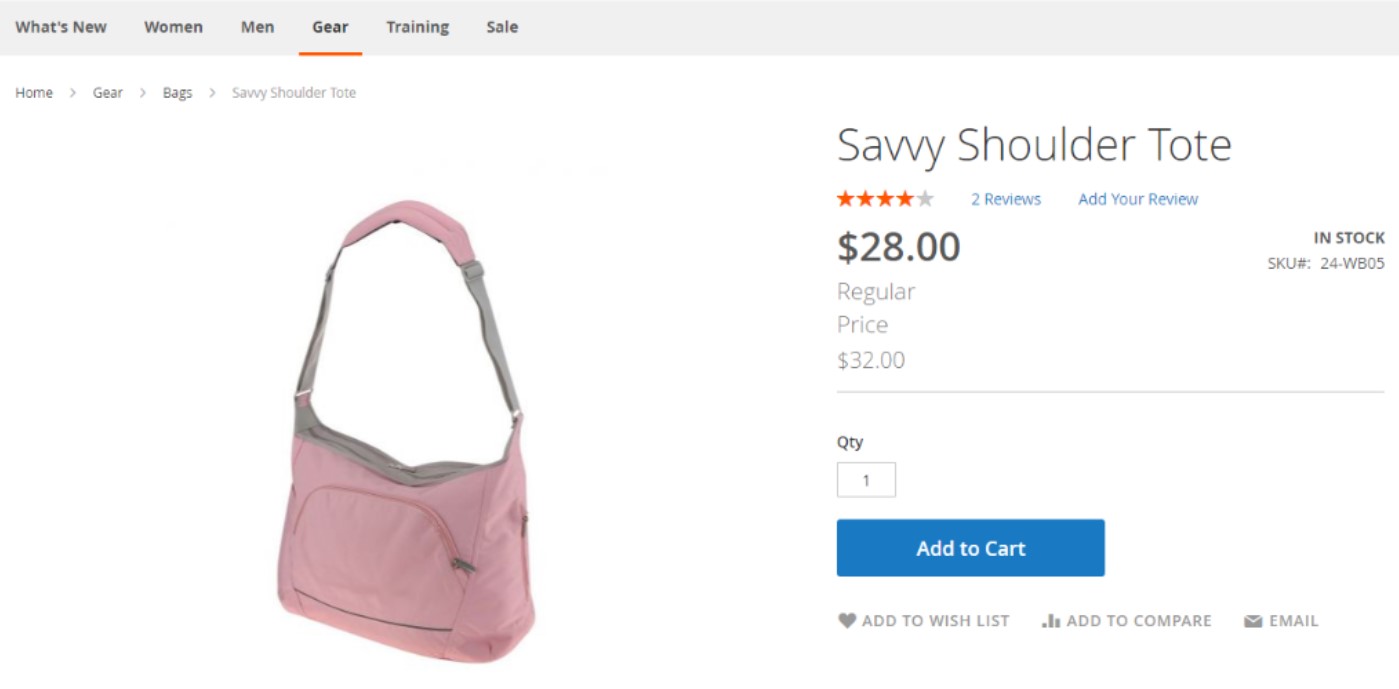
As for product browsing on Magento 2 websites, it includes a bunch of ecommerce solutions that make the life of your buyers better. First of all, you can display multiple images per product and let store visitors zoom them in. Displaying product videos from YouTube or Vimeo is another important feature of a standard product page.
To simplify the life of your buyers, Magento 2 adds swatches to a product page show colors, fabrics, and other parameters of a configurable product.
As mentioned above, you can enable related products, up-sell, and cross-sell recommendations.
Indicating stock availability on a product page is another good idea implemented in Magento 2. You can also display pricing tiers, add product ratings and reviews, show Facebook, Twitter, and email links, provide an option to add products to a wishlist, etc. Simple product sharing is another option, possible with any Magento 2 website.
If you don’t know how to transfer products from another website to your Magento 2 store, read this guide: The Complete Guide to Magento 2 Product Import / Export.
Checkout

Below, you can see various checkout enhancements of Magento 2.
Before going to the final destination, your customers can leverage a mini cart to summarize products that are already added. There is no need to go to a separate page because all the necessary data can be viewed from any place on your store. As for an ordinary shopping cart, it is enhanced with tax and shipping estimates.
When it comes to the checkout page, Magento 2 display an order summary with product images there. Note that both guest and registered user can checkout. Registered but not logged customers are automatically recognized after providing their email addresses.
You can enable unregistered shoppers to create a customer account with a single click on the checkout “thank you” page, using data provided on checkout.
If a customer doesn’t want to complete the checkout, they can save their shopping carts to complete their purchases later.
As a store administrator, you can enable gift wrapping and messages per order or per item as well as set pricing and taxes for gift-wrapping options.
To boost conversion rates for returning shoppers, Magento 2 lets you use the Instant Purchase checkout option. It lets buyers use previously-stored payment credentials and shipping information to skip checkout steps. As a result, the entire checkout procedure becomes faster and easier. Mobile shoppers benefit from this improvement the most.
Customer Accounts

Not every registered buyer visits their customer account, but there are still customers that spend some time there. To make their shopping experience better, Magento 2 provides access to a comprehensive dashboard with rich management features. Customers can choose default billing and shipping addresses and at the same time store unlimited addresses in the address book.
It is also possible to explore a current order status as well as a history of previous purchases. Re-order from a customer account is possible as well. Besides, a customer account is a place where buyers can track available store credits, gift card totals, and reward points.
It is also possible for managing newsletter subscriptions, viewing submitted product reviews, and accessing downloadable/digital products.
Advanced Analytics and Reporting
To provide you with actionable insights, Magento 2 Commerce offers up to 100 predefined reports that cover such areas as sales, marketing, customers, etc. You get started with up to 9 predefined dashboards. Moreover, it is possible to access dedicated B2B dashboards for company insights, sales rep, quoting KPIs, etc.
You can create new and edit existing reports using a visual tool. At the same time, the platform lets you leverage a built-in SQL report building editor.
To provide your team with insights, Magento 2 lets you send email summaries of key reports to team members. At the same time, you can export raw underlying data to CSV and Excel. But it is not the best way to integrate your store with an ERP system for instance. With Improved Import & Export, you don’t need to export any files, since everything is based on API integrations.
Layout and Theming
Although thousands of Magento 2 themes are available on various marketplaces, you can simply customize the responsive blank theme or the reference Luma store theme to accelerate time-to-market. Also, note that your base theme can be customized to create different store variations for countries, brands, campaigns, etc.
At the same time, it is possible to leverage Magento’s UI and pattern library to enable faster and more consistent theme development. In case you want to deal with this process of course. There are so many themes available so that you can find one that suits your needs without any customizations.
Besides, Magento 2 Commerce provides CSS preprocessing for easier site maintenance. You can also reduce frontend coding complexity splitting the presentation layer and business logic.
It is also worth mentioning that, the platform lets you create a website optimized for any device by leveraging the built-in responsive design reference themes, which are touch-friendly, easy-to-customize, and SEO optimized.
Performance and Scalability
Now, let’s take a look at performance and scalability improvements introduced in Magento 2 Commerce. Firstly, the new platform version leverages Varnish to accelerate the platform’s performance. The integrated Varnish page caching with multi-tier and multi-node configurations supports websites with the highest traffic. Besides, you can implement hole punching in addition to ESI to handle page elements that can’t be cached.
Secondly, Magento 2 commerce lets you benefit from faster indexing and incremental index updates. These features provide store visitors with fresher site content and better performance. At the same time, faster page loading is possible due to JavaScript, CSS, and HTML minification combined with image compression. Nother page speed optimization is based on the ability to cache all JavaScript and CSS on the first page viewed. This action minimizes content that must be downloaded for subsequent pages.
Thirdly, Magento 2 Commerce lets you store media files on a separate database server or via CDN for faster page load times.
As for the backend performance, the platform speeds up access to product, customer, and order grids due to faster Admin rendering. Furthermore, you can archive orders after a specified period to increase your store performance. Leverage the Magento Performance Toolkit to measure and optimize site speed!
Another notable performance improvement introduced in Magento 2 Commerce is the use of a Rabbit MQ job queue framework. With its help, the platform asynchronously processes tasks increasing the productivity of your website.
Also, note that pipeline deployment tooling is another notable performance optimization of Magento 2. This feature enables configuration management across environments and minimizes production downtime for updates.
With the support for MySQL Cluster, the platform scales database operations. It uses separate master databases to support checkout, order management, and product data. Furthermore, each master database can have multiple slave databases to scale read operations.
Last but not least, you can hire a large team of store administrators since multiple people can make concurrent order and product updates.
Managed Cloud
It is also necessary to mention that with Adobe Commerce Cloud, you get enterprise-grade reliability and availability with 99.99% uptime. Due to PCI-certified cloud infrastructure, the platform lets you process transactions with minimum risks.
Besides, the Magento cloud solution lets you benefit from PaaS-based environments for production, staging, and development. Note that they are entirely optimized for the Magento needs. It is also worth mentioning that the platform is built on an AWS-based cloud hosting infrastructure.
You can spin up, merge, clone and tear down environments. Adobe Commerce Cloud offers Production, Staging, and up to 6 Development environments. Besides, continuous cloud integration tools with support for unlimited users are under your disposal.
As for Magento cloud performance management, it is represented with unrestricted versions of New Relic APM Pro for performance monitoring and blackfire.io Enterprise for performance testing. You can accelerate site performance with Fastly’s CDN. Besides, it will prevent your website from DDoS attacks.
Another Adobe Commerce Cloud feature that is worth your attention is automatic backups of your code and databases. In case of any incident, you can restore them as fast as possible.
And as we’ve already mentioned, you can leverage various services to enhance the performance of your e-commerce website: Redis, RabbitMQ, and Elasticsearch.
Backend Exploration
Before going any further, let’s see how everything is arranged in the backend. Below, you will discover how the following admin sections look in Magento 2 Commerce:
- Dashboard;
- Sales;
- Catalog;
- Customers;
- Marketing;
- Content;
- Reports;
- Stores;
- System.
Dashboard
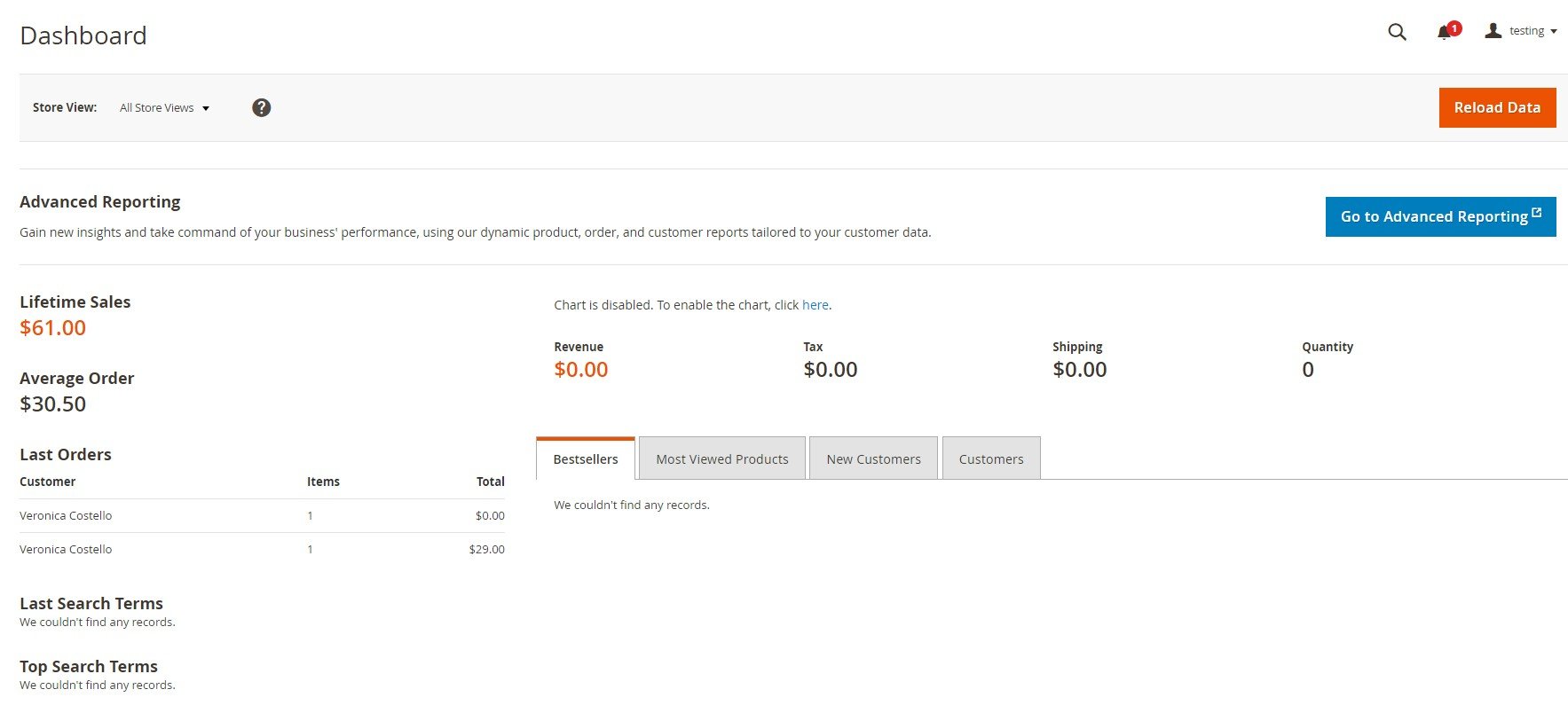
As you can see, the Dashboard section is quite straightforward: it displays lifetime sales, average order price, last orders, revenue, last and top search terms, etc. Besides, you can view bestsellers, most viewed products, new customers, and customers.
Sales
While the Dashboard section is relatively small, it provides tons of vital information about your online storefront. As for Sales, it is much bigger. The section is divided into the following parts:
- Quotes;
- Orders;
- Invoices;
- Shipments;
- Pickups;
- Dispatches;
- Batches;
- Credit Memos;
- Returns;
- Billing Agreements;
- Transactions.
Let’s explore each one.
Quotes
(hit this link for more in-depth exploration)
On this screen, you can find all the quotes. It is possible to turn them into orders or decline right in the grid. The screen contains all standards Magento backend instruments: filters, views, column configuration, export, etc. You can configure the number of quotes per page as well as use a search field. The grid shows all the necessary information about each quote: name, company, sales rep, quote total, etc.

Orders
(hit this link for more in-depth exploration)
A similar screen is available for orders. All the standard tools are in their common places. You can view purchase point and date, bill-to and ship-to name, grand total, and status right in the grid. For further information, proceed to an order page.

The corresponding page contains more data regarding the selected order. It is divided between 5 tabs:
- Information – all data about the order;
- Invoices – all related invoices;
- Credit Memos – all related credit memos;
- Shipments – all related shipments;
- Comments History – notes and events related to the order.
You can send an email, reorder or create returns from this page.
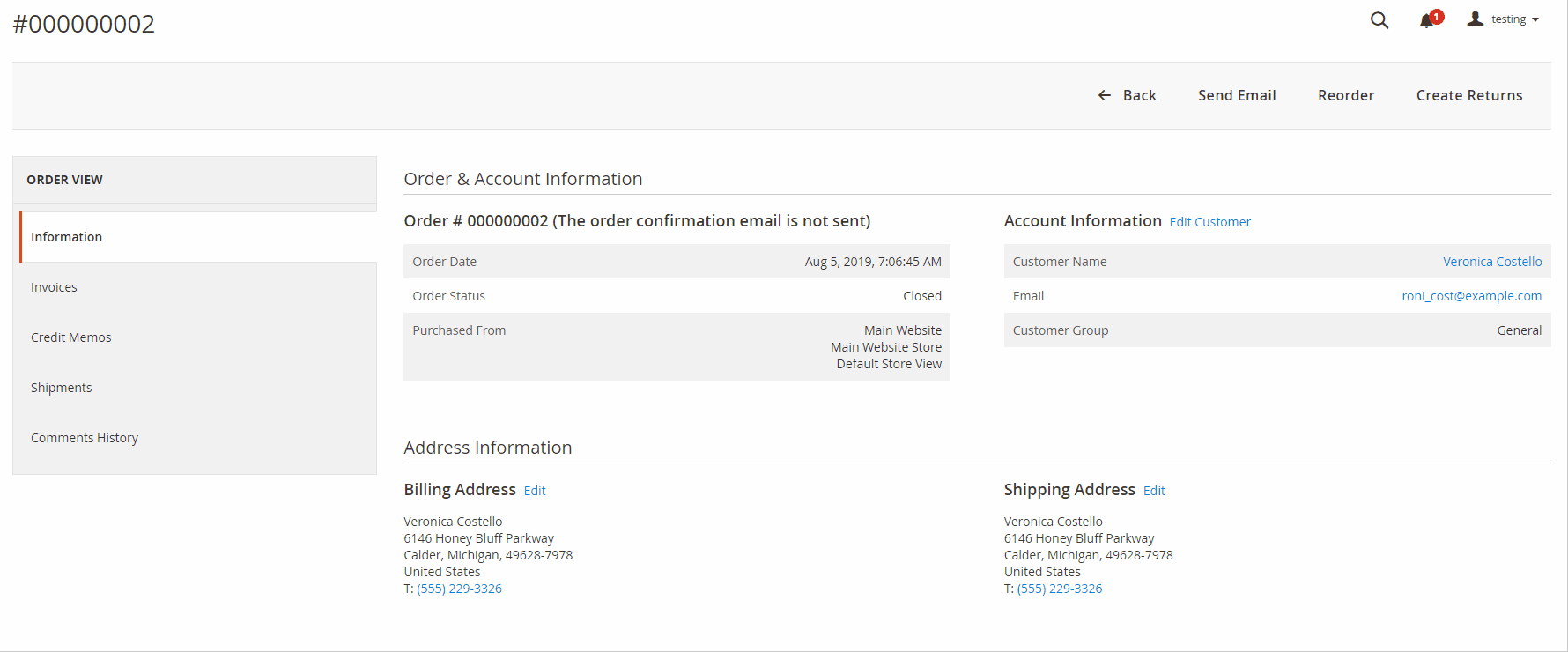
While creating a new order, you have to select a customer, for whom you create it, and then specify all the corresponding information: products, shipping and billing addresses, etc.
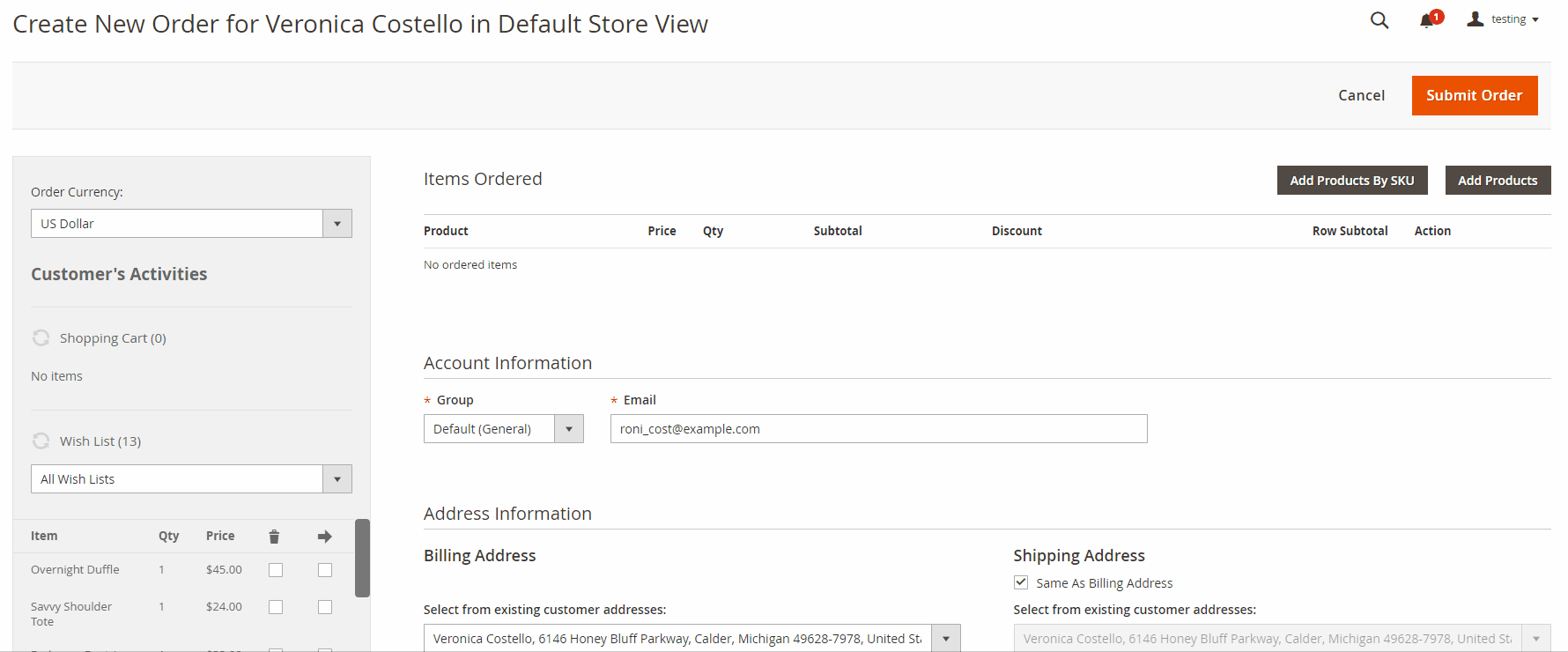
Invoices
(hit this link for more in-depth exploration)
The Invoices screen includes the corresponding documents from all customers. You can view every invoice separately or check the following data right in the grid: invoice date, order number, order date, bill-to name, status, grand total, etc.

A separate invoice looks as follows:
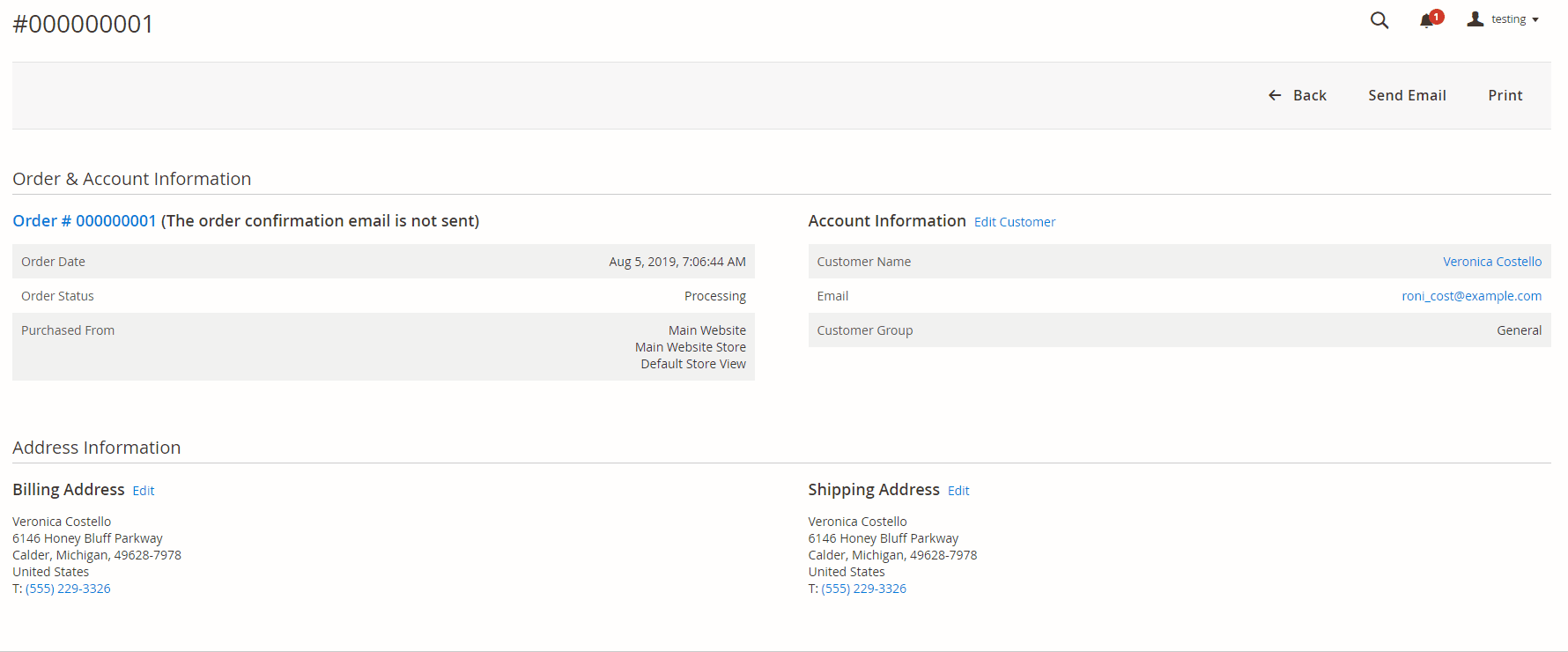
Shipments
(hit this link for more in-depth exploration)
The same situation is common for the Shipments grid:

Note that on a single shipment page, you can not only view all information this type of documents contains but also configure a carrier:

Pickups
(hit this link for more in-depth exploration)
This screen lets you manage pickups and print packing slips. You can view a related order, pickup ID, order data, customer name, origin location, ready for pickup date, and status:

Dispatches
You can find a review of dispatches here: Magento 2 Dispatches.
Batches
You can find a review of batches in this article: Magento 2 Batches.
Credit Memos
(hit this link for more in-depth exploration)
All credit memos are stored here:

Below, you can see a separate credit memo page:

Returns
(hit this link for more in-depth exploration)
Your screen with returns looks as follows:

To create a new return from the admin section, you have to select an existing order and view request details. Note that it is possible to leave comments here:
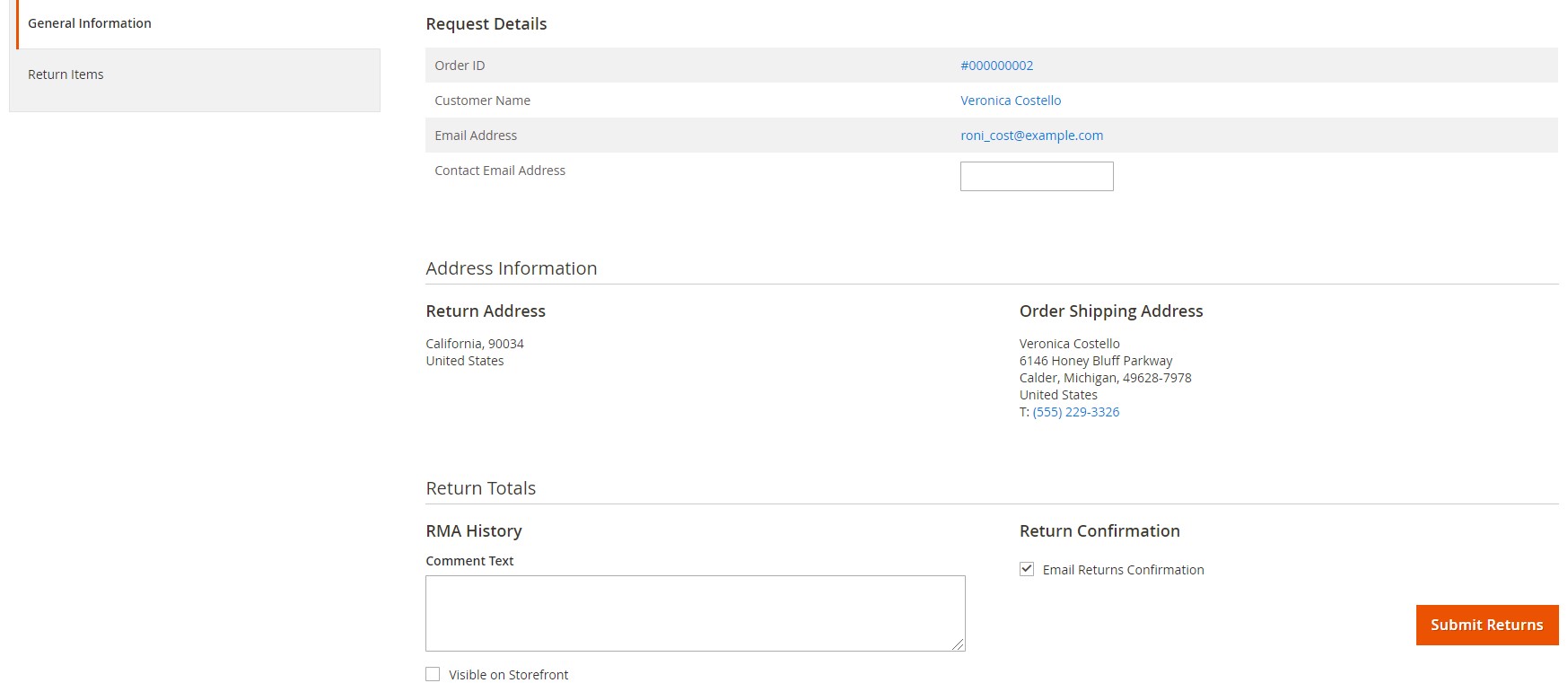
Also, add return items:

Billing Agreements & Transactions
Billing agreements and transactions are gathered in similar grids.
Catalog
The catalog section contains less elements:
- Products;
- Categories;
- Shared Catalogs.
Products
(hit this link for more in-depth exploration)
All products are gathered in a grid that displays their thumbnails, names, types, attribute sets, SKUs, prices, quantities, visibility, statuses, etc. You can edit each product or add a new one.
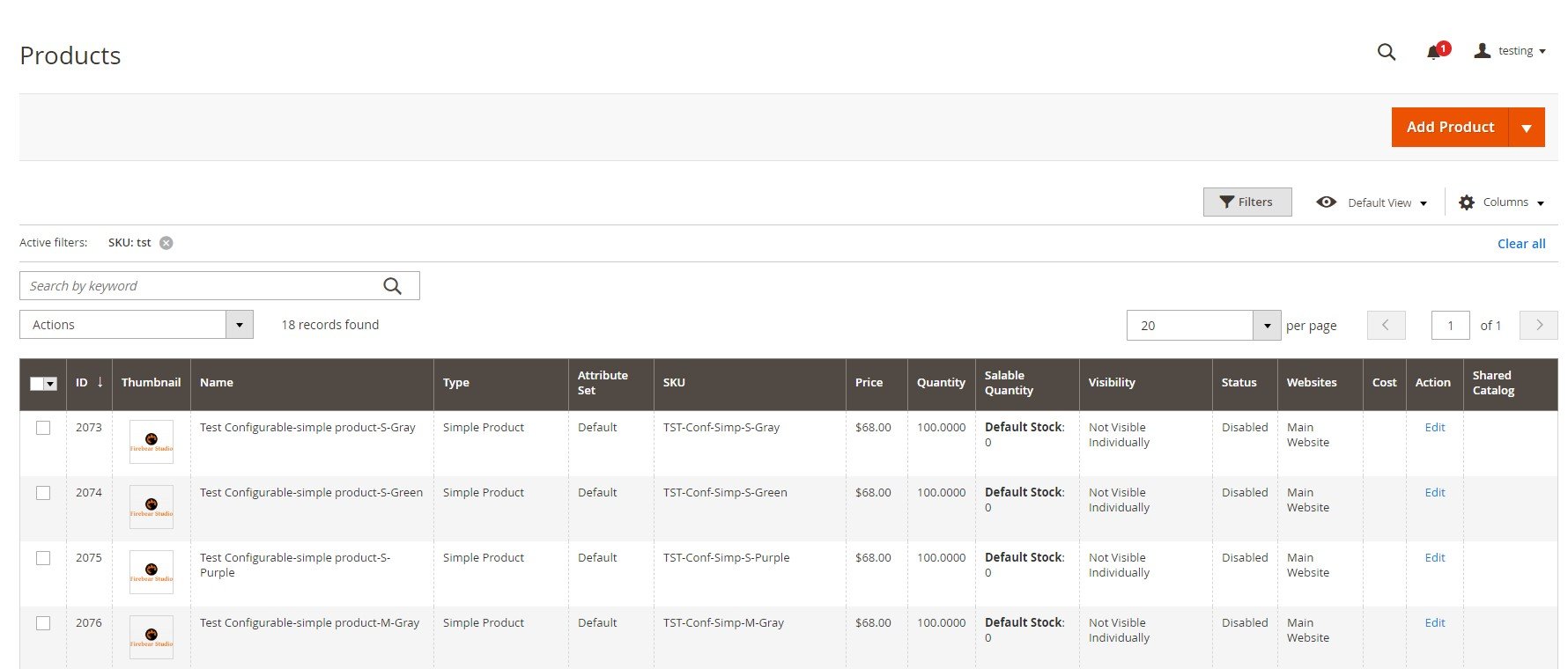
Creating a new product in Magento is a complex task because you can specify ALL possible parameters. Just take a look at how many tabs and options a product creation page contains:
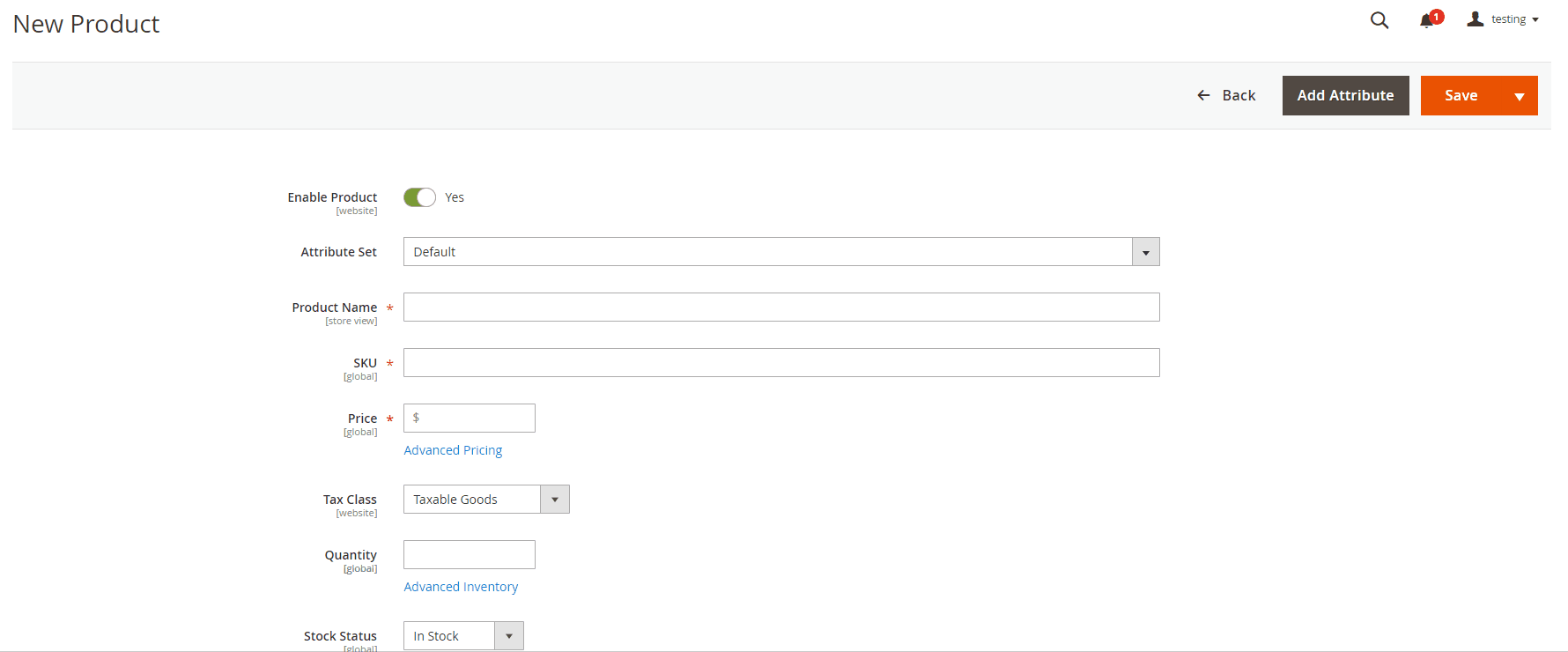
Categories
(hit this link for more in-depth exploration)
The same flexibility is contained in the Categories section. You can add new root categories or subcategories as well as edit the existing ones using the following interface:
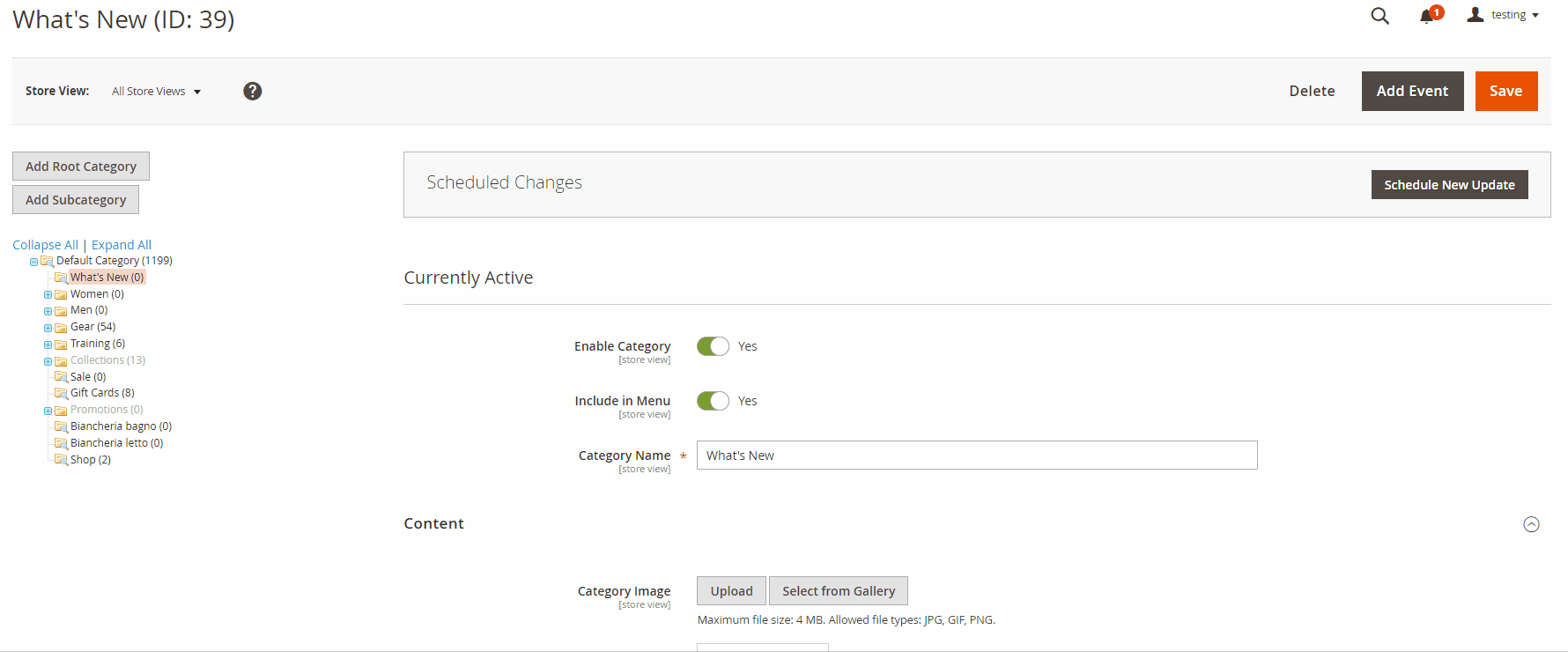
Shared Catalogs
(hit this link for more in-depth exploration)
Shared Catalogs are a Magento 2 Commerce-specific B2B feature, so you must enable it under Stores -> Configuration -> B2B Features to use on the storefront. The default Shared Catalogs grid looks as follows:

While adding a new shared catalog, specify its name, type, customer tax class, and description.

Customers
Now, let’s explore the Customers section of the Magento 2 Commerce backend. It is divided into the following parts:
- All Customers;
- Now Online;
- Segments;
- Customer Groups;
- Companies.
All Customers
(hit this link for more in-depth exploration)
All customers are gathered in the following grid:

Adding a new customer is not as complex as creating a new product:
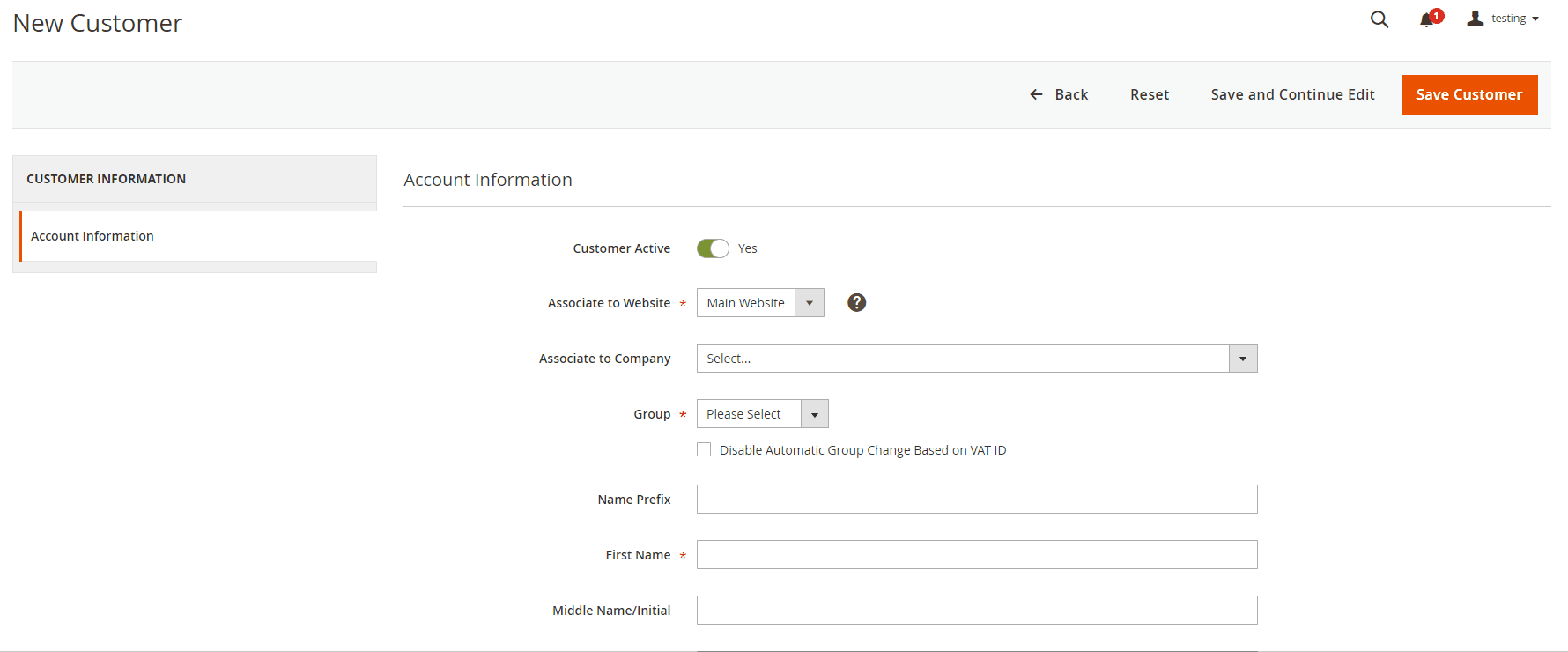
However, when you edit an existing customer account, the corresponding backend section includes many more options:
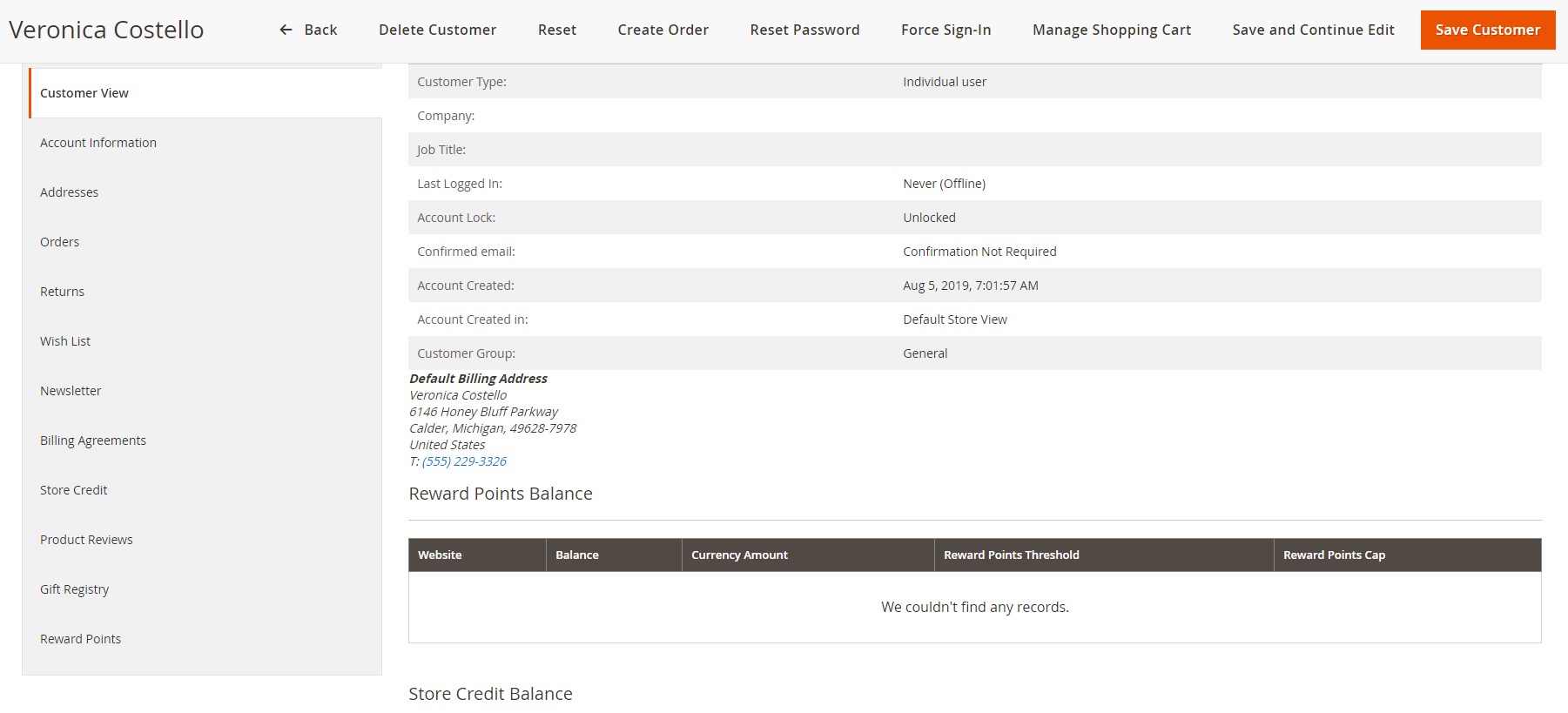
Now Online
(hit this link for more in-depth exploration)
All customers who are now online are displayed in this grid:

Segments
(hit this link for more in-depth exploration)
As for the advanced segmentation of Magento 2 Commerce, it is represented by the ability to create segments. The available ones are gathered on the following screen:

To add a new customer segment, specify its name, description, assigned website, status, and what customer groups it is applied to. Save this information to specify segmentation conditions.

Customer Groups
(hit this link for more in-depth exploration)
Customer groups are organized as follows:

Companies
(hit this link for more in-depth exploration)
Companies are a Magento 2 Commerce-specific B2B feature that has the following representation in the admin:

To add a new company, you have to specify multiple parameters:
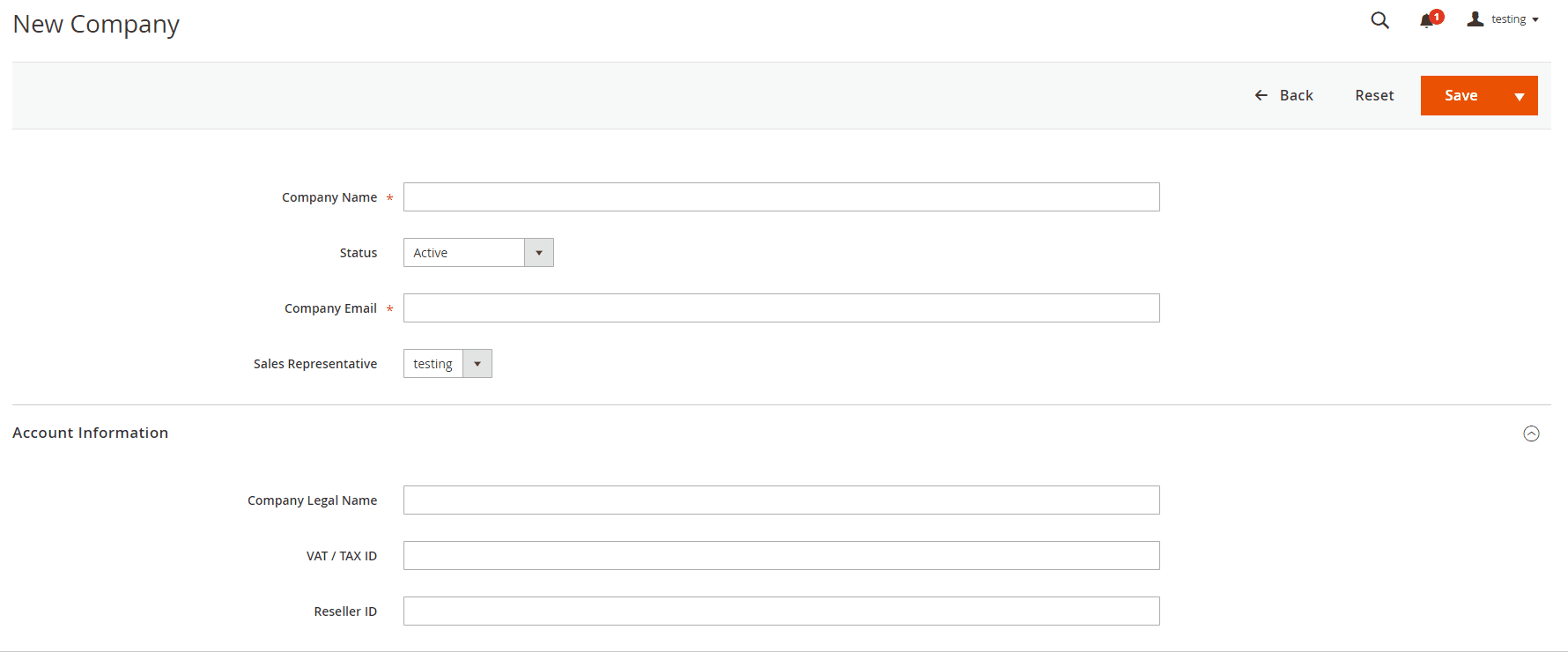
Marketing
The Marketing area of the Magento 2 Commerce backend is relatively big. It includes 6 sections: Promotions, Private Sales, Communications, SEO & Search, User Content, and Customer Engagement. Each one is divided into subsections.
Promotions
In Promotions, you will find the following grids:
- Catalog Price Rule (hit this link for more in-depth exploration)

- Related Products Rules (hit this link for more in-depth exploration)
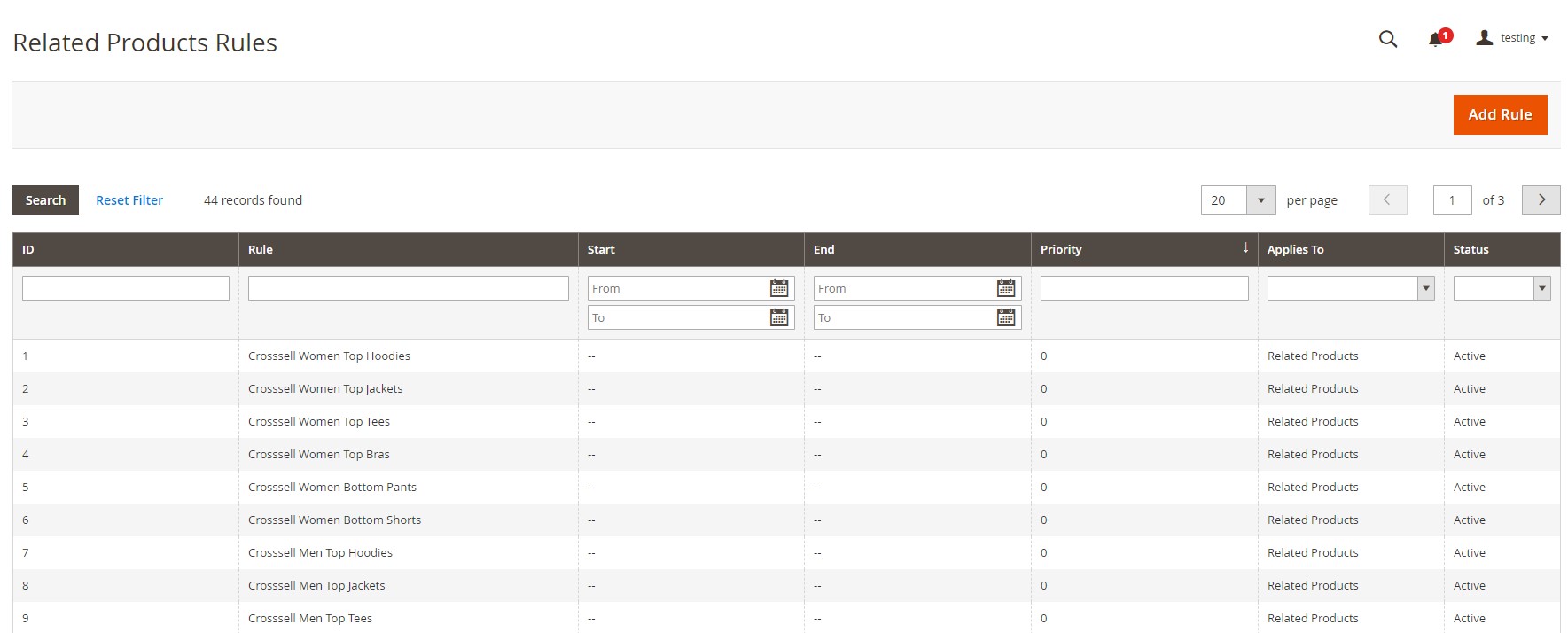
- Cart Price Rules (hit this link for more in-depth exploration)

- Gift Card Accounts (hit this link for more in-depth exploration)

On each screen, you can edit the existing items or add new ones.
Merchandising
Below, you can find links to our reviews of different merchandising features of Magento 2:
Private Sales
(hit this link for more information)
The Private Sales section is a little bit smaller. It contains only two screens:
- Events (catalog events)

- Invitations (to private sales)

Both grids let you manage their content as well as add new items.
Communications
In Communications, Magento 2 Commerce lets you store and manage the following data:
Advertising Channels
We describe the only existing ad channel of Magento 2 here: Magento 2 Advertising Channels. Despite the only default tool is left, several third party solutions provide a replacement. One such tool is mentioned in the article as well.
SEO & Search
(hit this link for more in-depth exploration)
Various SEO and search-related features are gathered in this section. You can manage the following items:
- URL Rewrites
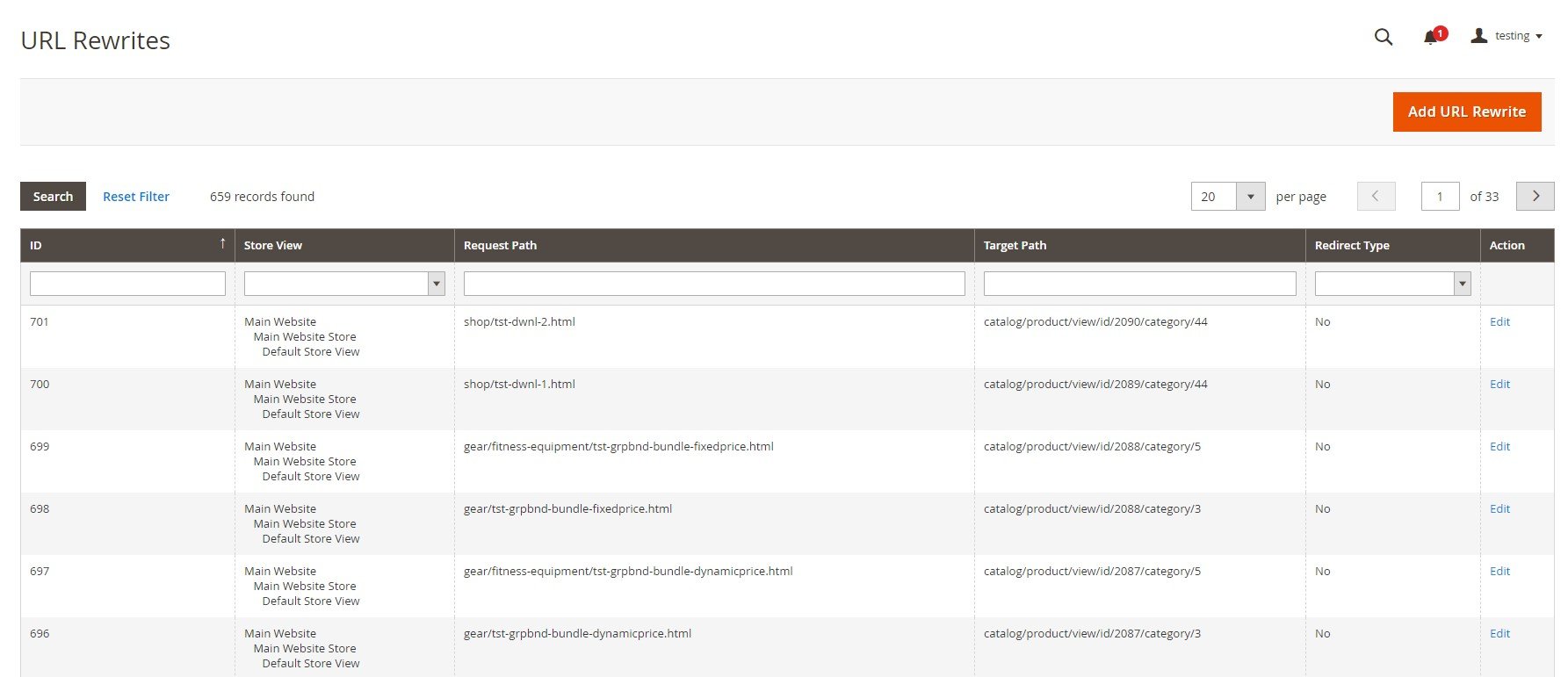
- Search Terms

- Search Synonyms

- Site Map

User Content
(hit this link for more in-depth exploration)
In this section, you can find user-generated content: existing and pending reviews.
The existing reviews are gathered in a grid:
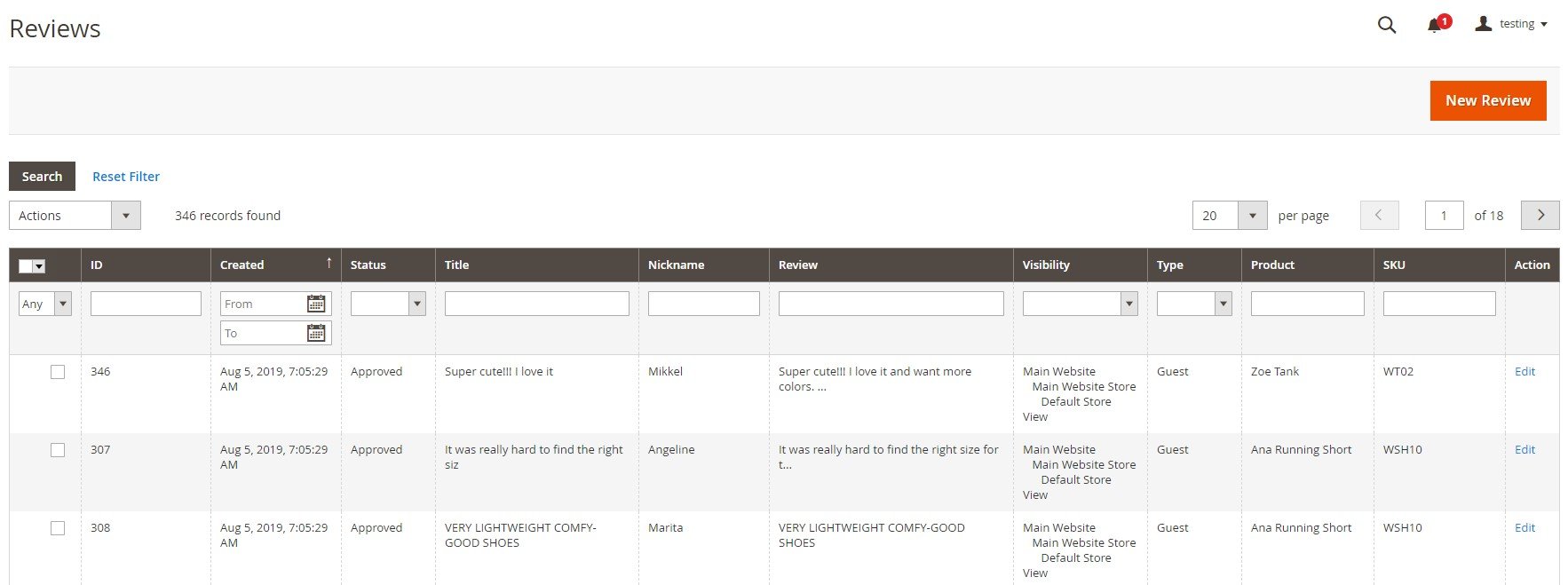
You can edit them or add new reviews right from the admin.
The Pending Reviews screen lets you approve or decline new reviews:

Customer Engagement
As for the Customer Engagement section, it includes Engagement Cloud which is described here: dotdigital Engagement Cloud. As for Exclusion Rules, this screen looks as follows:

Content
The Content part of the Magento 2 admin provides the ability to edit and create different elements and designs. Besides, it is a place where Content Staging section is situated.
Elements
The Elements section enables you to manage pages, blocks, widgets and other content types of your e-commerce website.
All pages are gathered in the corresponding grid that displays their key parameters: title, URL key, layout, store view, status, etc. You can view, edit or delete existing pages. Besides, it is possible to add new ones here:
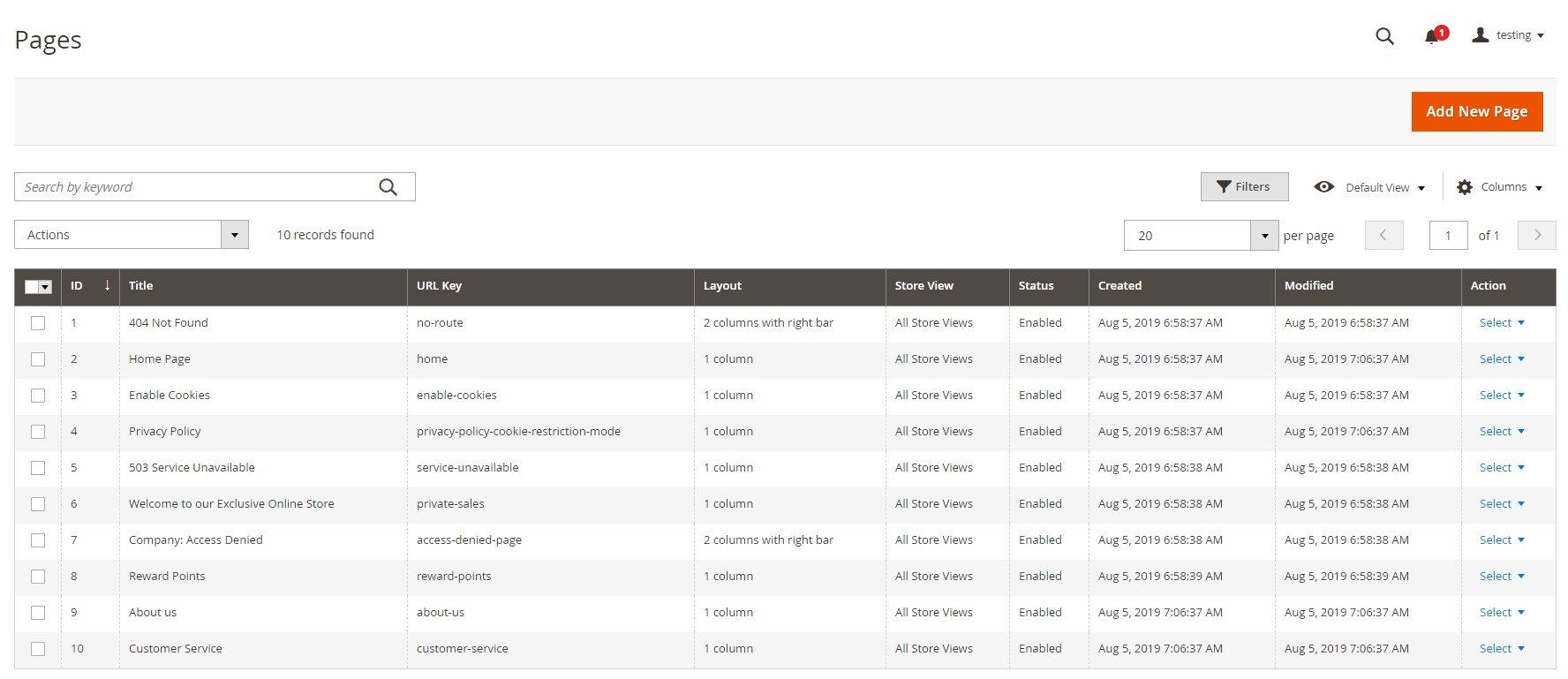
As for the hierarchy of CMS pages (more about CMS pages), it can be created on the corresponding page. You can create nodes and add selected pages to the tree (follow this link for a detailed guide):
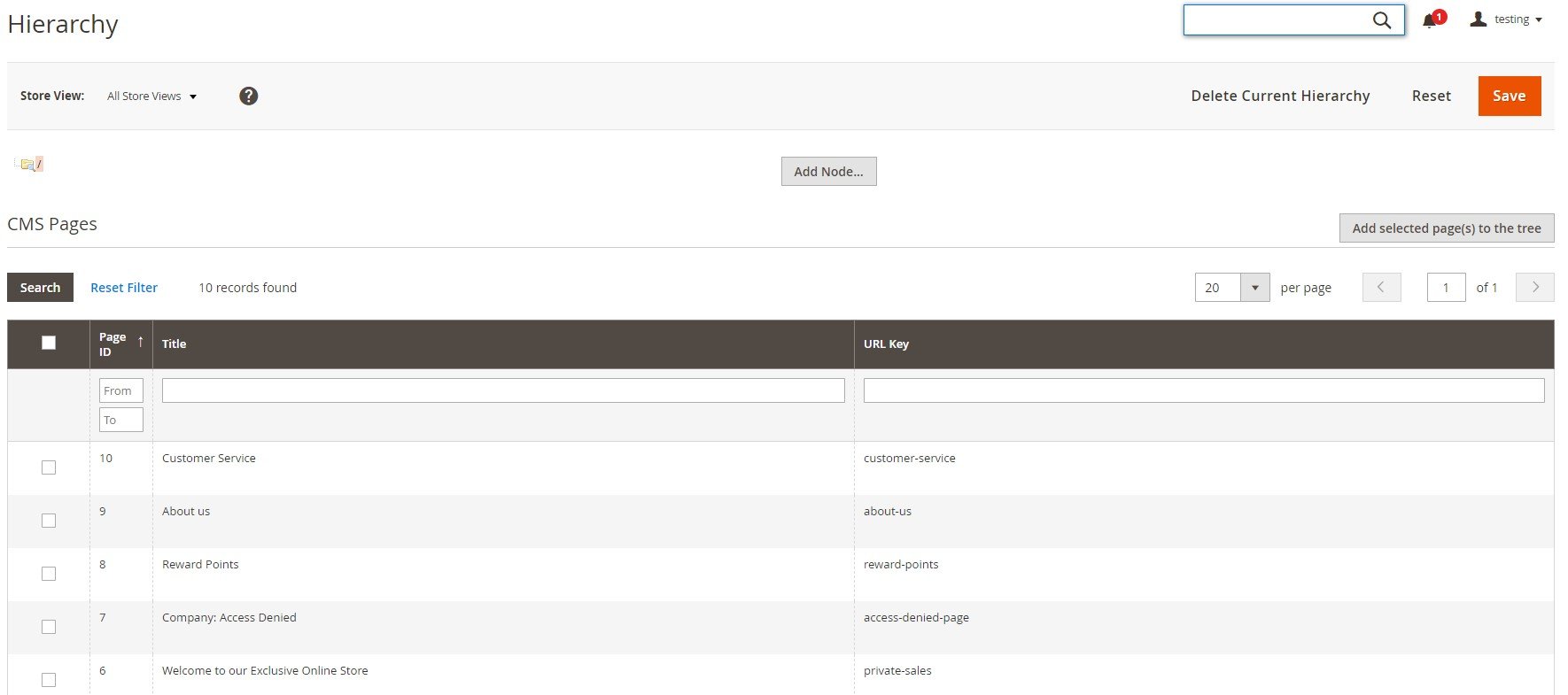
Blocks are stored in a grid as well. You can edit or delete them. The page lets you add new blocks (more about CMS blocks).

You can see the same situation regarding dynamic blocks (check a guide on this content type here: Magento 2 Dynamic Blocks):

Widgets also have their screen where you can add new elements and the existing ones (more about Widgets).
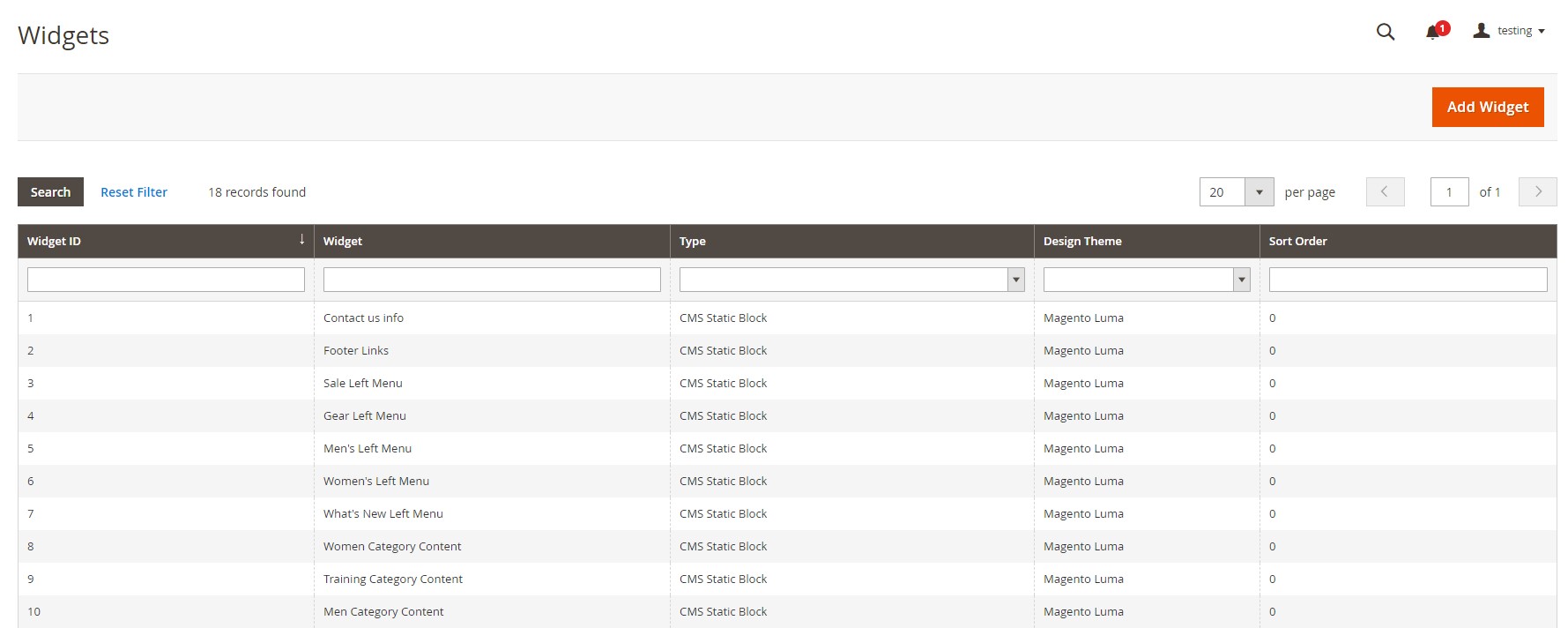
Design
In the Design section, you can edit the existing design configurations. We provide a step-by-step guide here: Magento 2 Design Configuration Tutorial.

View themes (you can find more information here):

And create schedules to apply different design configurations automatically:

Content Staging
The dashboard of this Magento 2 Commerce-specific feature shows active and upcoming design changes in the following way:

You can find the feature described here: Magento 2 Content Staging.
Reports
When it comes to reports, Magento 2 Commerce has a lot to offer. You can get the most in-depth insights into the following aspects of your ecommerce business:
- Marketing:
- Products in Cart;
- Search Terms;
- Abandoned Carts;
- Newsletter Problem Reports;
- Reviews:
- By Customers;
- By Products;
- Sales:
- Orders;
- Tax;
- Invoiced;
- Shipping;
- Refunds;
- Coupons;
- PayPal Settlement;
- Braintree Settlement;
- Customers:
- Order Total;
- Order Count;
- New;
- Wish Lists;
- Segments;
- Products:
- Views;
- Bestsellers;
- Low Stock;
- Ordered;
- Downloads;
- Private Sales:
- Invitations;
- Invited Customers;
- Conversions;
- Statistics:
- Refresh Statistics;
- Business Intelligence:
- Advanced Reporting;
- BI Essentials;
- Customer Engagement:
- Dashboard;
- Importer Status;
- Automation Enrollment;
- Campaign Sends;
- Cron Tasks;
- Log Viewer;
- Abandoned Carts.
A report page usually includes a grid with the corresponding data. You can export this information via CSV to provide it to external platforms. But, as we’ve already mentioned, Improved Import & Export is a more robust solution that lets you exchange data between Magento 2 and other systems via API. We review the core screens of this section here: Magento 2 Reports.
Stores
Under Stores, you can find multiple sections developed to configure the work of your e-commerce website.
Settings
In Settings, you can do a lot of things. For instance, All Stores lets you create new websites as well as manage the existing ones.

The Configuration screen provides the ability to enable/disable various Magento 2 Commerce features. The platform’s B2B settings are available here. Besides, you can configure third-party extensions.
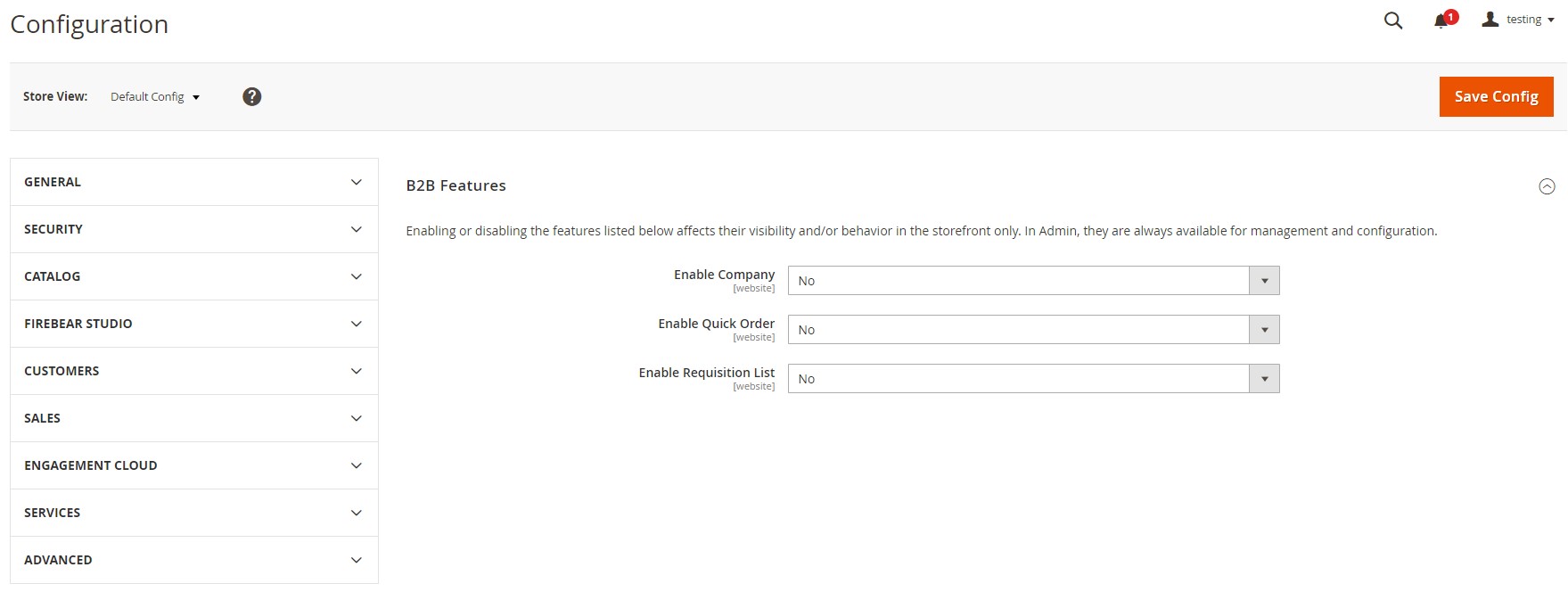
In Terms and Conditions, you can add new conditions or manage the existing ones.

On the Order Status screen, Magento 2 lets you create new statuses for orders. At the same time, you can unassign the existing ones.
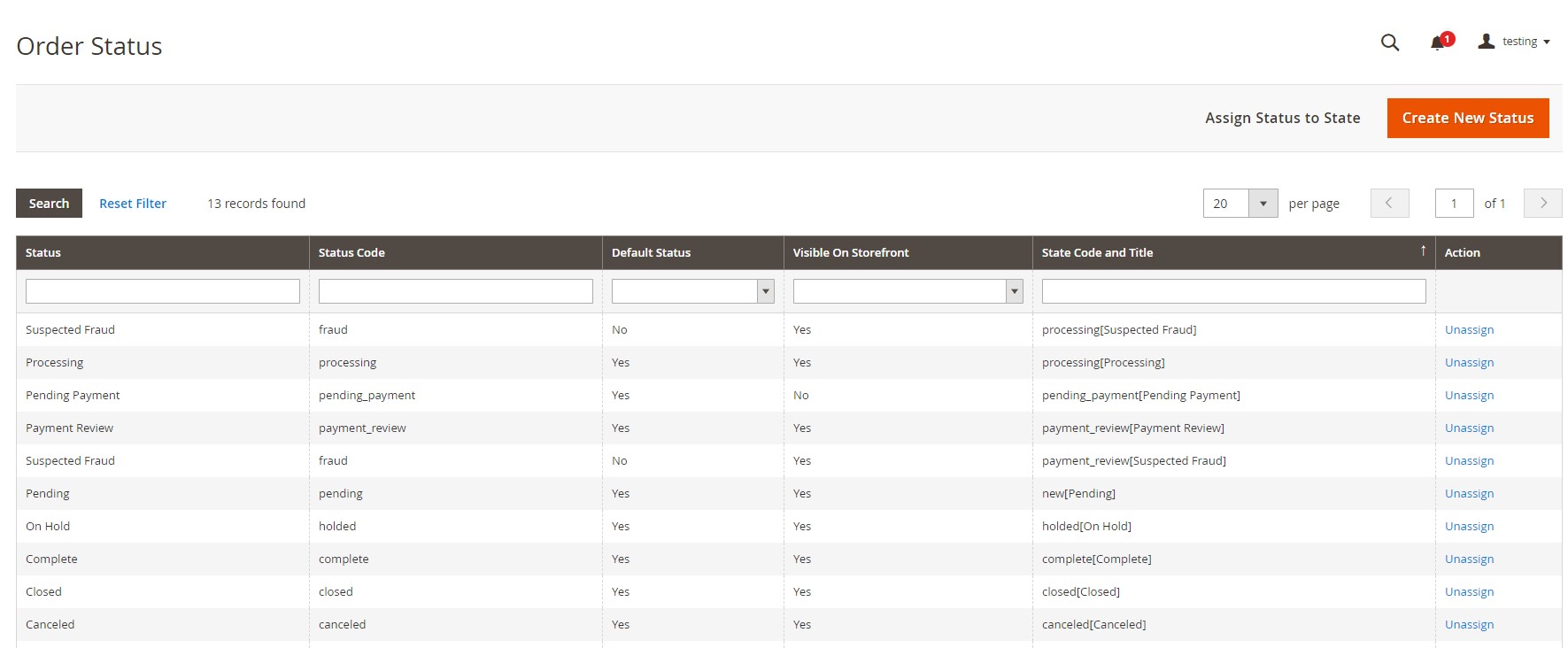
These four screens are described here: Exploring Magento 2 Backend: Stores/Settings.
Inventory
The inventory section lets you manage sources and stocks.
You can edit the existing sources or add new ones on the Sources screen.

The same is about stocks.

Taxes
(you can find more information here)
You can add new tax rules as well as view ones that already exist on the Tax Rules screen.

The same is about Tax Zones and Rates.

Other Sections
Since other sections are based on the same principle, we will only mention them in the list below:
- Currency:
- Currency Rates;
- Currency Symbols;
- Attributes:
- Customer;
- Customer Address;
- Product;
- Attribute Set;
- Returns;
- Rating;
- Shipping (deprecated):
- Carriers;
- Locations;
- Packaging;
- Experiences;
- Other Settings:
- Reward Exchange Rates;
- Gift Wrapping;
- Gift Registry.
System
The System section is so huge that it requires a separate article for more in-depth exploration. Depending on the installed third-party extensions, it may look different. In our case, the System, section has the following structure:
- Data Transfer (import and export operations):
- Improved Import / Export (our tools that replaces the previous instruments):
- Import Jobs;
- Export Jobs;
- Extensions (integrations with external systems):
- Tools:
- Support (instruments and features that gather information about the system)
- Permissions (different access roles and user permissions):
- Action Logs (history of everything that happens in your admin):
- Other Settings:

Pricing
When it comes to pricing, Magento is available into two options:
- Free Download. You can download Magento Open Source from the official website and install it on your own server, but it doesn’t include all the features described above. However, it is possible to get then via third-party extensions.
- Hosted Service. Magento Commerce is available as a hosted service, so you don’t have to install anything yourself. How you might have already guessed, the price is very high.
According to , Magento 2 Commerce is associated with the following license costs:
- $0 – $1 million – $22,000.00 – from 2.2% of your revenue;
- $1 – $5 million – $32,000.00 – from 0.64% of your revenue;
- $5 – $10 million – $49,000.00 – from 0.49% of your revenue;
- $10 – $25 million – $75,000.00 – from 0.30% of your revenue;
- $25 – $50 million – $125,000.00 – from 0.25% of your revenue.
As for the license costs of Magento 2 Commerce Cloud, they are the following:
- $0 – $1 million – $40,000.00 (+18k) – from 4% of your revenue;
- $1 – $5 million – $55,000.00 (+23k) – from 2.75% of your revenue;
- $5 – $10 million – $80,000.00 (+31k) – from 0.8% of your revenue;
- $10 – $25 million – $120,000.00 (+45k) – from 0.48% of your revenue;
- $25 – $50 million – $190,000.00 (+65k) – from 0.38% of your revenue.
Not to mention implementation and hosting expenditures!
Audience
Although Magento is an all-in-one solution for e-commerce with tons of features for the Commerce edition (or slightly limited functional if we talk about the free Open Source version), it is necessary to figure out the main users of the platform.
Magento 2 Commerce suits midsized and large shops that do well. If it is a small store, Open Source edition should be utilized instead. But if you have an established model with the necessary funding and reasonable expectations, Magento Commerce will fit your needs due to its scalability and short time-to-market. The platform will help you grow and face rising demand.
Being optimized to work in extreme conditions – thousands of products, tons of traffic, and a big number of sales – Magento 2 Commerce is developed for the bigger e-commerce stores out there.
Final Words
Now, when you are familiar with the core Magento 2 Commerce features, pricing, and users, we’d like to say a few more words about the platform. Another notable benefit of our favorite e-commerce system is its community. You can not only find developers to customize your store but also leverage thousands of third-party extension that dramatically improve the default functionality of the platform.
Of course, Magento 2 – especially its Commerce edition – can be overcomplicated for smaller stores. It requires some technical knowledge but the additional effort is completely worth it. You can start as a small business and grow into a giant market player due to the advanced scalability and huge potential of Magento 2.










